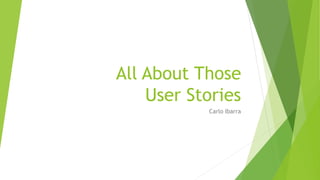All About Those User Stories
- 1. All About Those User Stories Carlo Ibarra
- 2. Requirements
- 3. What is a User Story? ’üĄ a written description of the story used for planning and as a reminder to discuss ’üĄ detail of the story ’üĄ tests that convey and document details and used to test if story is complete ’üĄ system of managing requirements in an iterative development ’üĄ 3 Cs - Card, Conversation, Confirmation
- 4. What Stories are NOT? ’üĄ NOT a detailed requirement ’üĄ NOT a technical specification ’üĄ NOT a documented contract ’üĄ NOT a software development plan (not SCRUM) ’üĄ NOT IEEE 830 ’üĄ NOT Use Cases ’üĄ NOT Scenarios
- 5. Parts of a User Story ’üĄ Description ’üĄ User role ’üĄ Business function/behaviour ’üĄ Business value ’üĄ Constraints ’üĄ Details ’üĄ Acceptance criteria
- 6. What Makes a Good Story ’üĄ a central character (user role) ’üĄ a plot - (function/behaviour) ’üĄ an ending - (test criteria) ’üĄ a lesson - (value to customer)
- 7. Writing User Stories ’üĄ Independent ’üĄ Negotiable ’üĄ Valuable to Customer/User ’üĄ Estimatable ’üĄ Small ’üĄ Testable
- 8. Independent ’üĄ Loosely coupled ’üĄ Stand-alone ’üĄ Avoid dependencies
- 9. Negotiable ’üĄ Emergent ’üĄ Encourages conversation ’üĄ Avoid creating "should have" or "must have"
- 10. Valuable (to Customer) ’üĄ Avoid technical requirements ’üĄ Aim for conversation ’üĄ Avoid zero-sum game
- 11. Estimatable ’üĄ Stories uses domain parlance and is understood by everyone ’üĄ Avoid jargons ’üĄ Helps development
- 12. Small and Testable ’üĄ Right size ’üĄ Clear criteria for doneness ’üĄ functional
- 13. Guidelines for Good User Stories ’üĄ Start with Goal Stories ’üĄ Slice the Cake ’üĄ Write Closed Stories ’üĄ Put Constraints on Cards ’üĄ Size the Story to the Horizon ’üĄ Keep the UI Out as Long as Possible ’üĄ Some Things ArenŌĆÖt Stories ’üĄ Include User Roles in the Stories ’üĄ Write for One User ’üĄ Write in Active Voice ’üĄ Customer Writes ’üĄ DonŌĆÖt Number Story Cards ’üĄ DonŌĆÖt Forget the Purpose
- 14. Story Smells ’üĄ Stories Are Too Small ’üĄ Interdependent Stories ’üĄ Goldplating ’üĄ Too Many Details ’üĄ Including User Interface Detail Too Soon ’üĄ Thinking Too Far Ahead ’üĄ Splitting Too Many Stories ’üĄ Customer Has Trouble Prioritizing ’üĄ Customer Won't Write and Prioritize the Stories













